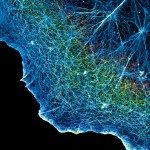Link to Pubmed [PMID] – 23113972
Microsc. Microanal. 2012 Dec;18(6):1419-29
For over a decade fluorescence microscopy has demonstrated the capacity to achieve single-molecule localization accuracies of a few nanometers, well below the ≈ 200 nm lateral and ≈ 500 nm axial resolution limit of conventional microscopy. Yet, only the recent development of new fluorescence labeling modalities, the increase in sensitivity of imaging hardware, and the creation of novel image analysis tools allow for the emergence of single-molecule-based super-resolution imaging techniques. Novel methods such as photoactivated localization microscopy and stochastic optical reconstruction microscopy can typically reach a tenfold increase in resolution compared to standard microscopy methods. Their implementation is relatively easy only requiring minimal changes to a conventional wide-field or total internal reflection fluorescence microscope. The recent translation of these two methods into commercial imaging systems has made them further accessible to researchers in biology. However, these methods are still evolving rapidly toward imaging live samples with high temporal resolution and depth. In this review, we recall the roots of single-molecule localization microscopy, summarize major recent developments, and offer perspective on potential applications.

